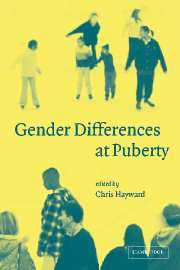Book contents
- Frontmatter
- Contents
- List of figures
- List of tables
- List of contributors
- Preface
- Acknowledgments
- 1 Methodological concerns in puberty-related research
- Part 1 Sex differences in hormones and their effect at puberty
- Part 2 Girls at puberty
- Part 3 Boys at puberty
- Part 4 Puberty and psychopathology
- Part 5 Pubertal timing: antecedents
- Part 6 Pubertal timing: consequences
- 12 Short-term and long-term consequences of early versus late physical maturation in adolescents
- 13 When coming of age means coming undone: links between puberty and psychosocial adjustment among European American and African American girls
- Part 7 Puberty and context
- Index
- References
12 - Short-term and long-term consequences of early versus late physical maturation in adolescents
Published online by Cambridge University Press: 22 September 2009
- Frontmatter
- Contents
- List of figures
- List of tables
- List of contributors
- Preface
- Acknowledgments
- 1 Methodological concerns in puberty-related research
- Part 1 Sex differences in hormones and their effect at puberty
- Part 2 Girls at puberty
- Part 3 Boys at puberty
- Part 4 Puberty and psychopathology
- Part 5 Pubertal timing: antecedents
- Part 6 Pubertal timing: consequences
- 12 Short-term and long-term consequences of early versus late physical maturation in adolescents
- 13 When coming of age means coming undone: links between puberty and psychosocial adjustment among European American and African American girls
- Part 7 Puberty and context
- Index
- References
Summary
We are all confronted almost daily with a major source of interindividual variation – people of the same chronological age vary tremendously in physical attributes and behaviors. Some look younger (and consequently may feel younger) than their age would predict, whereas others look older (and may disregard this entirely). A particularly impressive case of variation occurs during puberty: whereas some early adolescents appear physically almost fully grown, others still remind one of a child, and yet both may attend the same classroom and share the same chronological age. In the many domains of everyday interactions we adapt our behavior to the perceived age of others, our expectations and behavioral overtures toward young people may be inadequate; either we treat them like grown-ups (thus overtaxing capabilities) or like children (thereby underestimating potential). At any rate, it is likely that such behaviors, if persistent, could lead to age-inappropriate changes in the behavior of the young. Social reactions to physical maturation also vary widely across cultures. The onset of puberty in girls is universally followed by more restrictions than is observed for boys. Girls are subjected to menstrual taboos, dress codes, and limitations of their activities, whereas boys usually do not have to deal with increased supervision and limitations of their freedom (Petersen, Silbereisen, and Sörensen, 1996).
This chapter deals with interindividual variation in the timing of puberty and its association with differences in psychosocial functioning; as will be seen, this relationship is complex and goes well beyond the role of the social processes just mentioned.
- Type
- Chapter
- Information
- Gender Differences at Puberty , pp. 241 - 276Publisher: Cambridge University PressPrint publication year: 2003
References
- 53
- Cited by



